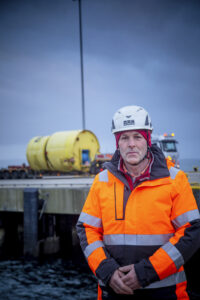Partnership potential

Wave energy leaders are targeting aquaculture as a potential development partner with the industries combining to harness the power of the ocean to their mutual benefit.
The prospect of taking energy from wave power units to run feed barges, feed pumping systems and farm-cage lighting, was a recurring theme during Wave Energy Scotland’s 2022 conference in Edinburgh, back in May of this year.
Wave power/aquaculture synergies are also being explored by Carnegie Clean Energy in North Fremantle, Western Australia, where the company’s MoorPower™ design is already earmarked to be used to power the feed barges that supply offshore fish farms. The unit is already the focus of an AUS $3.4m (£1.96m) project which includes input from two of Australia’s largest aquaculture companies, Huon Aquaculture and Tassal Group.
Starting at the WES event in Edinburgh, however, the idea that offshore fish farms could become one of the first commercial outlets for wave energy designers was headlined by Simon Grey, CEO of AWS Ocean Energy, Inverness.
He told Fish Farmer, “There are several points in favour of wave energy and aquaculture working together, especially as fish farms move further offshore into increasingly energetic sites, which are equally good for fish growth and wave power generation. The increasing size of modern aquaculture units is also creating opportunities for wave power units to be integrated into offshore structures, especially for an absorber design, such as our own company’s Waveswing unit.”
Designed to function as a submerged wave power buoy, AWS’s Waveswing reacts to changes in sub-sea water pressures, caused by passing waves, with the unit converting the resulting rise and fall motion of the water into electricity via a direct-drive generator.
Described by the company as a “simple telescopic can which pulsates beneath the surface”, the Waveswing unit is suitable for use in water depths of more than 25m, working either as a single buoy or as part of an integration into a multi-absorber structure. Measuring seven metres high and four metres in diameter, the Waveswing is capable of producing continuous power of 16kW in moderate seas.
The unit recently completed the first phase of sea trials at the European Marine Energy Centre (EMEC) in Scapa Flow, Orkney.
A swell idea?
“There are certainly ways in which the unit could integrate power generation into an aquaculture structure,” said Grey. “Fish farms clearly have a growing need for power in offshore locations. Feed barges, feed pumping and keeping lights on for growth and production purposes, all require a reliable energy source. Providing power for lighting, which is a predominantly winter demand, would sit well with our own peak power output period, when the waves are at their most active.
“We’ve had early discussions in the past with a few fish farming companies but are now at the stage where we would welcome more detailed customer engagement. We need to know what fish farmers really want, what risks they can tolerate and which they can’t. Clearly, with millions of pounds worth of fish in the sea, farmers can’t have power units that break free or ones that fail to produce power when needed.
“We can satisfy these requirements but need to start working with fish farming companies now so that our engineering design is totally in line with their needs.”
Adding wave energy to future fish farm designs will take time, however. AWS’s Waveswing unit isn’t forecast to be fully commercial for a decade, for example, although application to individual offshore farms should be before then.
“The point is that, if we’re to get wave energy delivering a meaningful contribution to Scotland’s net-zero targets by 2040, we need to start planning now,” said Grey. “We need a strategic roadmap for wave energy, based on proof of concept from developers and a valid business plan for the industry. Support for this isn’t going to come from venture capitalists, however. It will have to be backed first by government; only then will investors be willing to step up to take the sector forward.”
He is convinced, nevertheless, that Scottish waters have the potential to produce “hundreds of megawatts” of power.

Simon Grey, AWS Ocean Energy
More power for MoorPower
In Australia, meanwhile, Carnegie’s MoorPower unit is reported by the company to be nearing the completion of its commercial scale design, building on its earlier scaled demonstrator design.
“Progressing both the commercial scale design and the scaled demonstrator design will ensure that that the scaled demonstrator deployed in North Fremantle meets the requirements and objectives of our commercial scale customers,” says Carnegie.
Designed for use with moored vessels, the MoorPower system is seen as a solution to the challenge of securing clean and reliable energy for offshore activities, while also reducing the reliance on diesel generation.
The MoorPower project is being supported by funding from the Blue Economy Cooperative Research Centre (CRC) in Australia and is scheduled to be delivered in collaboration with a consortium of partners, including Huon Aquaculture and Tassal Group.
The project is set to run for two more years, during which time Carnegie is committed initially to design, install and operate a scaled demonstrator from its research facility in North Fremantle. Provided this demonstration period is successful, the company is confident that its major aquaculture industry partners will be “most likely” to become the first adopters of MoorPower as a commercial product.
The development of wave power to its current stage in Scotland has been backed by close to £48m of public funding since 2014, when Wave Energy Scotland (WES) was formed at the request of the Scottish Government. This is a level of commitment which is set to continue, according to Scotland’s Net Zero Minister, Michael Matheson, who told the WES2022 conference that he believed the country has reached “exciting time for wave energy”.
“You can be assured,” he told delegates, “that the Scottish Government will continue to provide its support for the development of marine and tidal energy in the years ahead.”

Impression of the MoorPower system aboard a barge

